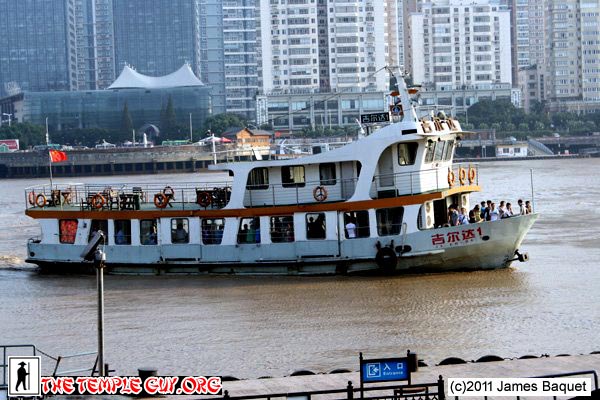(1) Today's temple, as befits its name, sits on an island in the middle of the Oujiang River. The name "Jiangxin Si" means "Heart of the River Temple," and it lies dead center between these pagodas. You can hardly make it out here...
(2) ...but here it is as the boat approaches.
(3) One peculiarity of this temple is that nowhere is the Shakyamuni Buddha found on a main altar. Instead, after the usual front hall with Milefo / Wei Tuo / The Four Kings, in the Main Hall there is a statue of Guanyin on the altar. This makes it a "Yuantong (圆通) Hall," (rather than a "Precious Hall of the Great Hero"), the name meaning something like "accommodating."
(4) This hall was also unusual in that it had a large collection of statues (38) along the sides. They were not the usual Arhats or Deva Kings, but rather a conglomeration of those and Buddhas, and even folk figures. Here's a long shot of the left side of the hall; I also shot them all individually for later study, though, disappointingly, many of the name labels had fallen off.
(5) Here's a group that makes the problem clear: obviously, that's a monk (one of Buddha's disciples?) in the center, flanked by what looks like a Biblical prophet on one side and a Chinese scholar on the other.
(6) My Indian friend Mr. Deep especially liked this one (reminded him of a girl back home?), while...
(7) I preferred this dragon king.
(8) These plaques across the back of the main hall have images of and poems about Guanyin; I shot them all to add to my future research load.
(9) The third and last hall was a Three Sages of the West Hall; here's a wide view of the interior. This temple had a larger percentage of Guanyin figures in key positions than any temple I've seen.
(10) Over the centuries, lots of Buddhas have been beheaded (some not so long ago). It was sometimes perpetrated by vandals, and sometimes by "collectors" (looters). This panel is in the wall separating the Main Hall from the back hall; I think the replacement of the heads will be obvious even at this scale.
(11) The temple is situated on an island with lots of gardens (and even an amusement park). Here's a nearby bridge.
(12) This stupa was designated a "relic stupa." The relics in question seem to belong to a monk named "Muyu" (Wooden Fish) who died in 2006. To be only a monk (not a "master") who died so recently, and have such a memorial, is extraordinary. I'm looking forward to learning more about him. One page I found says wonders accompanied his funeral (a sunny day after long rains, "five color auspicious clouds," etc.)
(13) This is the West Pagoda (left as we viewed it from the river). The sign says it's not certain whether the tower was built in the Tang Dynasty (869 A.D.) or the Song (969 A.D.). Unusual transparency.
(14) My friend Harriet recently asked about the "feeling" of the temples; when I told her some were better than others, she said she was "hoping they were all sacred and mystical." I've included this shot and the following to show something of the dichotomy between the old and new (and incidentally how the photographer edits the environment). So, first, the "wonderful"...
(15) ...and zoom out to the not-so.
By the way, in 1894 the British built their consulate next to this pagoda; for the sake of "security," they had the roofs and floors stripped from it (if I'm reading the Chinglish signboard correctly). The result was a hollow, roofless tower where, strangely, a banyan tree took root at the top, with its roots never reaching soil; as the sign puts it so eloquently, "such as a spectacle."
(16) Next to Jiangxin Temple is a memorial hall to Wen Tianxiang, a scholar/official who opposed Genghis Khan's takeover at the end of the Song Dynasty. At one point (maybe 1276?) he spent a month on this island while on the run, and wrote two poems about the temples and "his decision of reviving the country," according to the sign. Six years later, he was executed by the Mongols at the age of 47. Remarkably, the first memorial hall to Wen was built here in 1482, 200 years after his death. It has been rebuilt and repaired several times over the years and, as the sign says, "now it has been decorated into the new."
(17) Here comes our ride! Time to head home. (I tried doing a Jack Dawson "I'm the king of the world!" moment in the bow to entertain a group of four 20-something guys, but all I did was confuse them. Not film buffs, I guess. Mr. Deep had no comment.)
+ + + + + + + +
So this was our last "official" temple of the trip; we may try to catch one more in Ningbo between the arrival of our train from Wenzhou and the departure of our plane to Shenzhen. As we'll be getting home late (and school starts Monday), those pics (if any) may take a few days to get posted.
Thanks for following.
(18) We weren't able to see anything Saturday because of train connections, etc. But we did have a great Indian lunch in Ningbo, and a pleasant (on-time!) flight home. That's it, then, for this pilgrimage; watch for more in a few weeks. I'll just head on down the trail... (Image by Mr. Deep from our short hike out of Gaoming Temple.)
| ← Previous Site | Back to Trip 11 Introduction | Next Site → |
Last August 7, 2019



















No comments:
Post a Comment